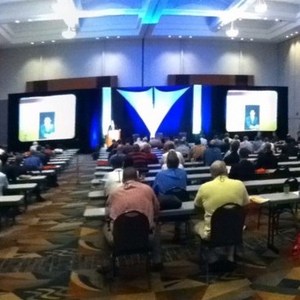Cellulosic leaders talk feedstock procurement at Neb. event




September 12, 2013
BY Chris Hanson
In front of an attentive crowd at the 2013 National Advanced Biofuels Conference & Expo in Omaha, Neb., representatives from Abengoa Bioenergy S.A., Poet-DSM Advanced Biofuels LLC and Ineos Bio presented updates on their cellulosic ethanol projects and feedstock procurement activities.
Tom Robb, co-products project manager for Spain-based, Abengoa showcased the company’s cellulosic plant in Hugoton, Kan. He said the plant is the product of 10 years of technical development, roughly 30,000 hours of commercial and demonstration plant operation, and 100 people working in research and development.
Robb said the plant receives 320,000 dry tons of biomass harvested within a 50 mile radius each year. Of that biomass, 82 percent is comprised of irrigated corn stover, 7 percent irrigated wheat straw, 7 percent milo stubble and 4 percent switchgrass.
To secure the feedstocks needed, Robb explained how factors such as supply chain risks, weather and competitive uses were addressed by the company. He said the relatively dry climate of Kansas was a major benefit for the Hugoton plant site. “If you get rain or snow during your harvesting time, that could put a bind in your operations,” Robb said. “We’re less dependent on mother nature here.”
Advertisement
Additionally, Robb spoke about the dynamics between Abengoa, biomass owners and grain facilities. He said demonstrating stewardship principles, demonstrating synergies for biomass residue management with farming practices, and working within customary business practices are necessary when interacting with biomass owners.
Next, Steve Hartig, general manager at Poet-DSM, addressed the feedstock procurement efforts leading up to the opening of Project Liberty plant in Emmetsburg, Iowa. He said the plant’s feedstock needs can be secured with the corn residue from one-third of the corn acres within a 35 mile radius of the facility. Hartig said corn residue was selected as the feedstock for the project due to a plentiful local supply, existing business relationships with farmers, and the presence of standard harvesting equipment, which eliminates the need for farmers to purchase additional equipment.
To acquire the feedstock, Hartig explained Poet-DSM is contracting farmers through two models. One custom model is designed for one or three year contracts with farmers, in which Poet arranges and manages all of the procurement work and rewards the farmer with an access fee. Longer contract follow the farmer model, in which farmers handle the harvest and storage operations and receive payment for the residue.
Finally, Ineos Bios’ Vice President Dan Cummings presented its cellulosic ethanol and power generation facility in Vero Beach, Fla. He explained Ineos acquired the technology since 2008, but the project has been under development for more than 20 years. The facility began cellulosic ethanol production in July and is projected to produce 8 million gallons of ethanol per year. “It is a long journey to bring all these technology to commercial scale,” Cummings said.
Advertisement
Florida was selected for the site due to the extended growing period for the vegetative waste that is used as feedstock. “They grow year round, there’s quite a bit of quantity there and it’s also a very large ethanol market,” Cummings said. He added they have used more than six kinds of waste biomass in the commercial scale facility, including woody biomass, citrus waste, Australian pine, and palm fronds from tree trimmings.
In addition to producing cellulosic ethanol, Cummings noted the facility also generates 6 megawatts (MW) of renewable electricity. “We started producing renewable power this time last year,” he said. He added the steam to power the generator is also used to dry the feedstock and incorporated into the distillation process.
“For all of this, it has taken a lot of patience and hard work,” Cummings said. “I think that’s true for the entire industry and I think that you just have to impress upon folks that you do need to have patience when commissioning a plant.”
Upcoming Events





